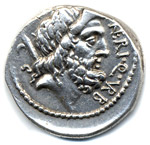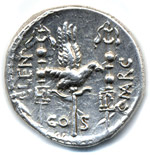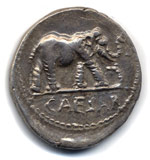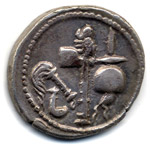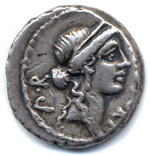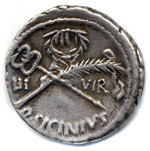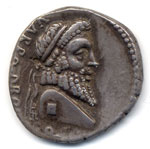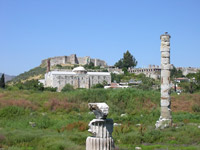Crossing the Rubicon: The Coins of 49 BC
RRC 441/1
Obverse: Head of Saturn right with harpa over
shoulder; before, NERI·Q·![]() B
downwards. Border of dots.
B
downwards. Border of dots.
Reverse: Legionary eagle; on left, standard of maniple
of hastati; on right, standard of maniple of principes;
on left, L·LE![]() upwards;
on right, C·MARC upwards; below, CO S. Radiate border.
upwards;
on right, C·MARC upwards; below, CO S. Radiate border.
RRC 443/1
Obverse: Elephant right, trampling dragon; in exergue,
CAESAR. Border of dots.
Reverse: Pontifical emblems – culullus, aspergillum,
axe and apex. Border of dots.
RRC 440/1
Obverse: Head of Fortuna Populi Romani right, wearing
diadem; before, FORT downwards; behind, P·R upwards. Border of dots.
Reverse: Palm-branch tied with fillet and winged caduceus,
in saltire; above, wreath; below, Q·SICINIVS; on either side, III VIR.
Border of dots.
RRC 445/3b
Obverse: Head of Jupiter right. Border of dots.
Reverse: Artemis of Ephesus facing; on right, L·LENTVLVS
downwards; on left, C·![]() C·COS
upwards. Border of dots.
C·COS
upwards. Border of dots.
Caesar's decision to cross the Rubicon in 49 BC sparked off a civil war between the remaining two Triumvirs. The coins issued in this year provide good evidence of the rhetoric evinced by Caesar and his opponents.
There is a clear contrast between the minting practices of Caesar and Pompey; while Caesar only minted a single type in 49 BC, the issue was a large one, advertising his position and imminent victory. Pompey's supporters employed more coin types, but minted these in smaller quantities, and none alluded to the contemporary situation of civil war.
The large-scale movement of soldiers in this period, from Gaul to Rome under Caesar, and from other places during the first year of the civil war, is also alluded to on the coinage. A coin (RRC 441/1) minted in Rome by Cn. Nerius (Quaestor Urbanus at the time) shows on the reverse a legionary eagle and military standards, alluding to the fact that the coin may have been struck for military purposes.
It is perhaps no coincidence that it was in 49 BC (Woytek 2003:124) that Caesar chose to issue his first coin, with himself as the issuing authority. (RRC 443/1) The issue was produced by a mint moving with his army. The reverse of this coin alludes to Caesar's position as Pontifex Maximus, while the obverse shows an elephant trampling a dragon or a snake, with the legend CAESAR in the exergue. The specific meaning of this reverse image is debatable. Babelon (1885/6 vol 2:10ff) identified the dragon as a sign referring to the Germans and concluded that the coin showed the victory of Caesar over the Germanic tribes. Crawford (1974:735) believed that it symbolised victory over evil. Backendorf (1998:210ff) argued that the snake and elephant represented the beginning of the civil war, since Romans believed the snake and the elephant were constantly at war with each other. Pliny noted that snakes and elephants come from India and that there is a continual feud between them; “in this duel both combatants die together, and the vanquishing elephant in falling crushes with its weight the snake coiled round it” (Pliny, NH 8.32). Backendorf believed the animals might allude to Pompey and Caesar. The elephant also had strong associations with Alexander the Great and it is quite possible that Caesar wished to allude to the great conqueror.
The Republican politicians (optimates) were certainly confident of victory at the beginning of the war (Cicero de. imp. Pomp 45). Q. Sicinius, a moneyer who joined the side of Pompey, issued a coin (RRC 440/1, probably early in 49 BC) showing on the obverse the head of Fortuna Populi Romani (the Fortune of the Roman People) and on the reverse symbols of victory and felicitas (good fortune).
While Pompey himself did not strike coinage, his supporters struck coins throughout 49 BC, using mints that travelled with the general. Coins were struck for Pompey by the moneyer Q. Sicinius, the praetor C. Coponius, the consuls L. Lentulus and C. Marcellus, the proquaestors Cn. Piso and Varro and an anonymous quaestor (RRC 444/1, 445/1-3, 446/1, 447/1). In large part these coins display deities and, in the tradition of Roman Republican coinage, allude to the previous exploits of each moneyer's family. Gods included Apollo, Hercules, Artemis and the head of the Roman pantheon, Jupiter. The coins do not specifically allude to any precise Pompeian cause. The presence of some of the gods on these coins can be explained by the location of Pompey when they were minted. For example, RRC445/3b showing Jupiter on the obverse and cult statue of the Ephesian Artemis on the reverse is perhaps a reflection of the fact that the coins were minted in Asia, near Ephesus. Likewise, a coin of Pompey showing Apollo (RRC 445/2) seems to indicate that the mint was located at Apollonia.

